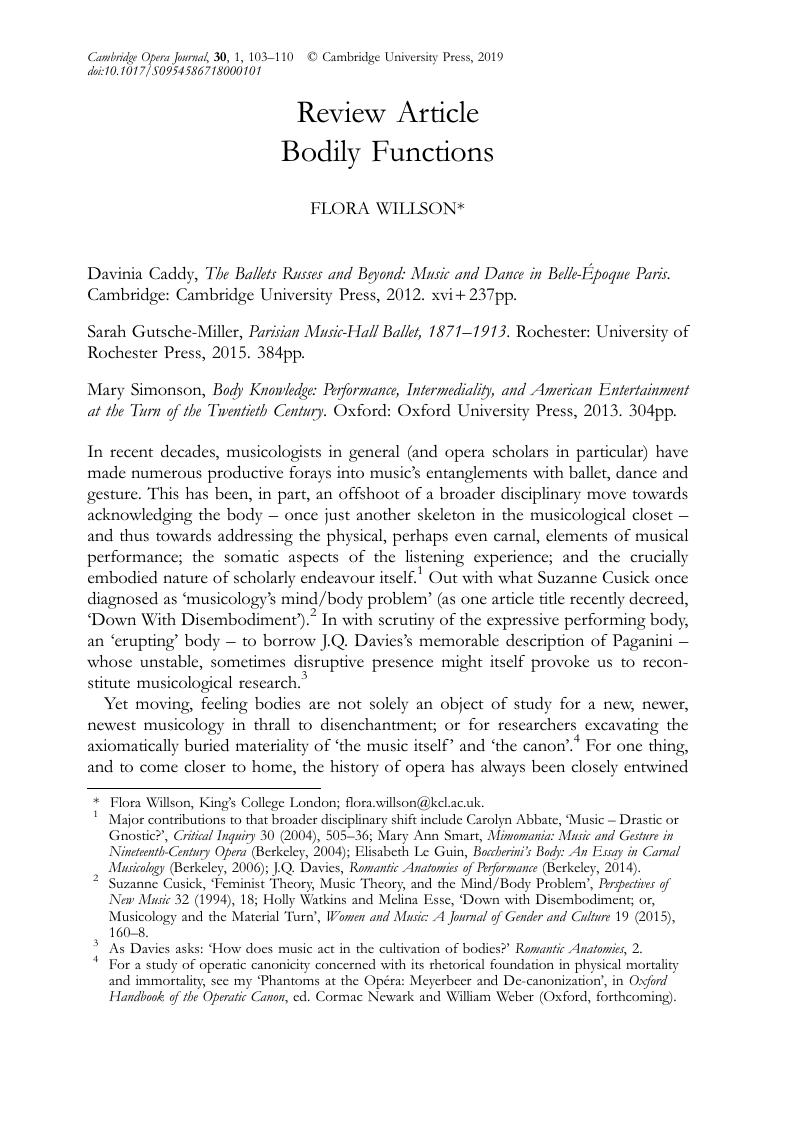No CrossRef data available.

Flora Willson, King’s College London; flora.willson@kcl.ac.uk.
1 Major contributions to that broader disciplinary shift include Abbate, Carolyn, ‘Music – Drastic or Gnostic?’, Critical Inquiry 30 (2004), 505–536 Google Scholar ; Ann Smart, Mary, Mimomania: Music and Gesture in Nineteenth-Century Opera (Berkeley, 2004)CrossRefGoogle Scholar ; Le Guin, Elisabeth, Boccherini’s Body: An Essay in Carnal Musicology (Berkeley, 2006)Google Scholar ; Davies, J.Q., Romantic Anatomies of Performance (Berkeley, 2014)Google Scholar .
2 Cusick, Suzanne, ‘Feminist Theory, Music Theory, and the Mind/Body Problem’, Perspectives of New Music 32 (1994), 18 CrossRefGoogle Scholar ; Watkins, Holly and Esse, Melina, ‘Down with Disembodiment; or, Musicology and the Material Turn’, Women and Music: A Journal of Gender and Culture 19 (2015), 160–168 CrossRefGoogle Scholar .
3 As Davies asks: ‘How does music act in the cultivation of bodies?’ Romantic Anatomies, 2.
4 For a study of operatic canonicity concerned with its rhetorical foundation in physical mortality and immortality, see my ‘Phantoms at the Opéra: Meyerbeer and De-canonization’, in Oxford Handbook of the Operatic Canon, ed. Cormac Newark and William Weber (Oxford, forthcoming).
5 See Susan Rutherford, “‘La cantante delle passioni”: Giuditta Pasta and the Idea of Operatic Performance’, Cambridge Opera Journal 19 (July 2007), 107–38; Henson, Karen, Opera Acts: Singers and Performance in the Late Nineteenth Century (Cambridge, 2015)Google Scholar .
6 See Roger Parker, ‘Reading the Livrets, or the Chimera of “Authentic” Staging’, in Leonora’s Last Act: Essays in Verdian Discourse (Princeton, 1997), 126–48; Newark, Cormac, ‘Ceremony, Celebration, and Spectacle in La Juive ’, in Reading Critics Reading: Opera and Ballet Criticism in France from the Revolution to 1848, ed. Roger Parker and Mary Ann Smart (Oxford, 2001), 155–187 Google Scholar ; and Smart, Mimomania.
7 The foundational musicological text on changing audience behaviours during the nineteenth century remains Johnson, James H., Listening in Paris: A Cultural History (Berkeley, 1995)Google Scholar .
8 See, for example, Smith, Marian, Ballet and Opera in the Age of Giselle (Princeton, 2000)Google Scholar ; Harris-Warrick, Rebecca, Dance and Drama in French Baroque Opera: A History (Cambridge, 2016)CrossRefGoogle Scholar ; Lockhart, Ellen, Animation, Plasticity, and Music in Italy, 1770–1830 (Berkeley, 2017)CrossRefGoogle Scholar .
9 For a more in-depth examination of the term’s meanings outside media studies (a guide cited by Simonson herself), see Rajewsky, Irena O., ‘Intermediality, Intertextuality, and Remediation: A Literary Perspective on Intermediality’, Intermedialities 6 (2005), 43–64 Google Scholar .
10 Even soprano Lillian Nordica gets a cameo: she featured on the billing for a Hellenistic pageant, Suffrage Allegory, to be staged in Washington DC on the eve of President Woodrow Wilson’s inauguration, though in the event was replaced by the German actress Hedwig Reicher; see Simonson, 59–61.
11 Un Monsieur de l’Orchestre, ‘La Soirée Théâtrale’, Le Figaro (12 April 1893), quoted by Gutsche-Miller, 28.